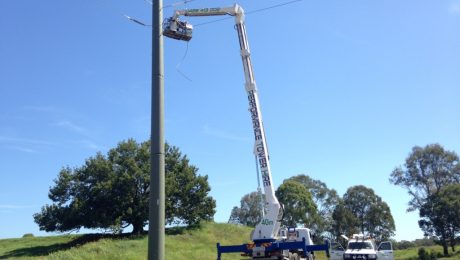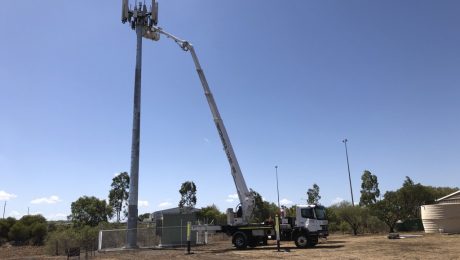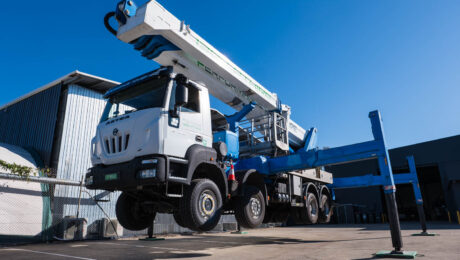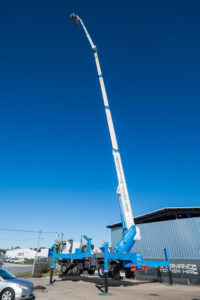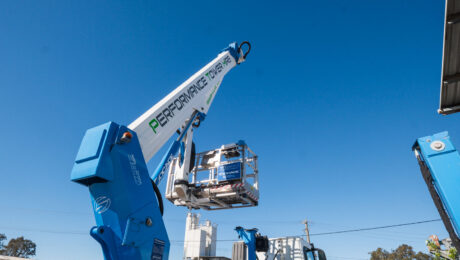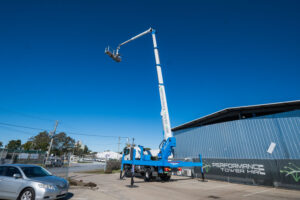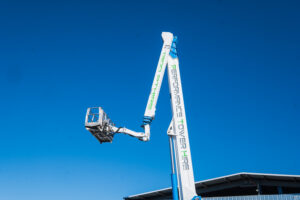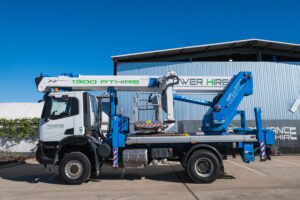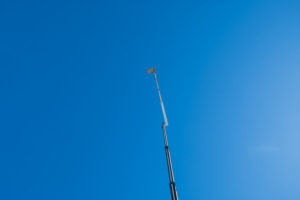Looking to hire a truck-mounted boom lift, but want to know just how high they go? If so, this is the article for you.
Truck mounted boom lifts are the highest elevated working platforms available on the Australian market. In this article, we will discuss how high a boom lift can go, how to choose the right height for your boom lift and where to go if you need a truck mounted boom lift.
How High Does a Boom Lift Go?
While boom lifts are considered to be the elevated working platform able to reach the highest of heights in the Australian industry, how high your boom lift goes will depend on the type of boom lift you hire.
The smallest boom lift reaches a height of (7m), whereas the largest go all the way up to 341 ft (104m).
How to Choose the Right Boom Lift (and Height) for Your Needs
There are several factors that go into ensuring you have the right boom lift (at the right height for your intended purposes. Here, we’ll discuss some of the things you really need to consider when choosing the right boom lift (and height) for you:
The Height You Need to Work At
It might seem obvious, but the height you need to work at is one of the major things you need to take into account when hiring a truck mounted boom lift. There’s no point in hiring the largest one on the market if you only need to reach heights of 40m.
Location & Access
Location and access also play a large part in determining the type of truck mounted boom lift you require. Our boom lifts are mounted on trucks so there needs to be access for them to set up safely and manoeuvre the lift without risking the safety of others.
Safety
While we’re on the topic, let’s talk about safety. There are many safety measures you are legally required to follow when operating a boom lift. You need to make sure you have the right safety equipment (and wear it) before operating the equipment and have the correct and proper training for the type of machine you are using…
Weight Capacity
The weight a boom lift can carry – be it one person or a couple of people – can be up to 600kg, depending on the type of boom lift you choose and other restrictions that may be in place.
As such, you need to be certain that you will not exceed this when using your boom lift. That’s why our equipment is fitted with load cells to ensure the capacity is not exceeded. Failure to do so may result in damaging your equipment as well as risking your own safety and that of others.
Intended Purpose
Boom lifts are only designed to carry workers, so if you need to lift a load not intended to be in the basket of the machine, you should make alternate arrangements.
Using a boom lift for something outside its intended purpose (as a crane, for instance) can result in damage and potential safety issues, especially if you consider the weight of the load you are trying to lift.
Why Use Performance Tower Hire When Sourcing Boom Lifts
In Queensland and Australia, there are many laws and restrictions governing the safe operation of a boom lift – even a truck-mounted boom lift like the ones we provide.
And even if you are licensed and able to operate the equipment, it can still be a dangerous thing.
When you work with Performance Tower Hire, however, you don’t have to worry about that. Our equipment is some of the best available on the market, ready to go when you need it complete with a highly trained and skilled operator so you can focus on the job at hand.
If you need a reliable, quality truck-mounted boom lift, or other hire equipment on your construction site, contact our experienced team today or make an online booking.
Truck Mounted boom lifts are one of the highest elevated working platforms in the industry, but just how safe are they?
In this article, we’ll discuss whether truck mounted boom lifts are safe, boom lift safety procedures, and where to go if you want to be certain the boom lift you’re hiring is safe.
What’s a Boom Lift?
We’ve discussed before what a boom lift is, but for the sake of this article, let’s briefly touch upon it again.
A truck mounted boom lift is the highest reaching elevated working platform available to the Australian market.
It’s ideal for working at extreme heights that other machinery cannot reach and commonly used for everything from painting tall buildings, to installing lighting in stadiums.
Are Boom Lifts Safe?
Because they are the type of machinery you use when working at extreme heights, their operation does come with a certain amount of risk – presumably much more than other elevated working platforms which only reach your average heights.
That said, with the right safety equipment and a fully qualified operator (such as those we have on staff at Performance Tower Hire), it is perfectly safe to use a boom lift.
What Do You Need to Be Aware of When Operating a Boom Lift?
There are several things you need to be aware of when operating a boom lift. In this section, we’ll discuss them briefly.
Safety & Qualifications
Safety is paramount when operating any elevated working platform, but it’s especially important when using a boom lift. To operate a boom lift safely, you must be fully trained and licensed according to state and federal protocols.
You must also wear a full body harness, hard hat, goggles and other safety equipment as dictated by Government regulations.
A huge consideration you should also make when operating a boom lift ties directly into safety and the safe operation of the machinery around power lines. Electricity is volatile and you must maintain a safe distance from power lines at all times when working with the assistance of this lift.
If you fail to do this, you risk putting yourself and others in harm’s way, which is not considered safe practice when operating a boom lift.
Be Aware of Your Surroundings
When operating a boom lift safely you should always be aware of your surroundings. This includes making sure the moving components of the boom lift are not likely to hurt anyone when it’s in operation.
If necessary, clear the area completely and remove any potential hazards, even if the risk of there being an issue is only minor.
Load Capacity & Limitations
Being a safe boom lift operator means adhering to all and any load capacity or load limitations you may have. It is especially important to check this if you are unfamiliar with the boom lift, or you haven’t worked with it in a while.
Don’t Use it Outside its Intended Purpose
This point ties into the previous one, but is worth singling out. Any elevated working platform – including a boom lift – is only intended to assist workers complete the tasks they need to perform at heights.
As such, they are not always designed to be used to carry equipment and supplies – this is the job of a crane.
How to Be Certain of Safety During Boom Lift Operation
As much as you try to avoid it, accidents can happen. In our opinion, there’s only one way you can be certain of safety while operating a boom lift: leave it to the experts at Performance Tower Hire.
All our hire equipment – from boom lifts to cherry pickers and everything in between – is thoroughly inspected and certified as safe before use. And we have a team of qualified, experienced operators you can trust to get your work done without worrying about safety.
To find out more about our boom lift hire options and the safety procedures we have in place, contact Performance Tower Hire today.
Do you need a licence to operate a cherry picker? Using a cherry picker in Queensland isn’t just about being comfortable behind the controls. There’s a high chance you need a license to operate it, too. Whether you need one depends on a few things: the height of the machine, the training you’ve had, and the kind of hire setup you’re working with. Licensing is very important to on-site safety.
Not sure if you need a licence for the job? It’s definitely one of the questions you need to ask when hiring an EWP. We’re going to break it down for you today – no confusing terms, just what you need to know.
EWP Licence Basics in Queensland: What You Need to Know
Under 11 Metres: Yellow Card Training
If the cherry picker or boom lift you’re using goes up to 11 metres or less, here’s some good news, you don’t need a High Risk Work licence. That said, it’s not a free pass to just jump in and start operating. You still need to know what you’re doing and take the right safety steps.
You still need to be adequately trained. That’s where the EWPA Yellow Card comes in.
The Yellow Card is recognised across Australia as a form of verification that you’ve been trained in using different types of elevated work platforms (EWP).
The Yellow Card serves as proof that you’ve received proper training and know how to handle the machine safely. Even if the law doesn’t always ask for it, almost all employers will, especially when safety or insurance is on the line. It’s one of those things that helps keep everyone covered.
Over 11 Metres: HRW Licence WP Class Required
If the cherry picker has a platform height over 11 metres, you’ve crossed into high-risk work territory.
To operate that kind of gear, you’ll need a High Risk Work licence with the WP class. No shortcuts here, it’s a legal requirement under Queensland law.
To get your HRW licence, you’ll need to:
- Do training through a Registered Training Organisation (RTO)
- Demonstrate competence in a theoretical and practical assessment that proves you understand and can operate the machine and work safely
- Lodge a licence application through Workplace Health and Safety Queensland
These rules aren’t there just to make life harder. When you’re that high up, the risks are real. Working near power lines, on the side of a busy road, or in bad weather – the risks add up.
If you’re unsure how high your job might take you, check out our guide on how high a cherry picker can reach, it’s a good starting point before choosing your gear or training path.
What Happens If You Don’t Have the Right Licence?
If you get caught operating a boom over 11 m without the proper licence, the fines can sting, both for you and your employer. And what if an accident is involved? Expect serious legal and financial trouble. It’s not worth the risk.
Why Does Height Matter?
More height = more danger. The higher you’re working, the tougher it is to react if something goes wrong. A sudden fault at 12 metres is a much bigger deal than the same problem at six metres.
That’s why Queensland draws a clear line at 11 m. Below that, training is strongly recommended. Above that, the law requires you to be fully licensed.
Are There Age Restrictions on Obtaining Your Yellow Card?
Yes there are. You can start Yellow Card EWP training at 16. That means younger workers can get trained and ready early, but there’s a catch. If you’re under 18, chances are you’ll need someone keeping an eye on you while you’re on site. That’s mostly because companies and insurers usually want operators to be 18 or older before they’re trusted to run the equipment solo.
If you haven’t used a cherry picker before, it’s worth getting familiar with the safety stuff early on. That matters even more if you’re learning while on the job or there’s someone guiding you through it.
Why are there restrictions for under-18s?
It’s all about making sure things stay safe. Using an EWP takes sharp judgment and quick thinking, and that kind of instinct usually comes with a bit of time on the tools. The rules are really just there to help younger operators ease into it without being thrown in the deep end.
Why Must Training Be Done Through an RTO?
RTOs are nationally accredited to provide training that meets industry standards. They don’t just hand out certificates, they assess you against the current standards and make sure you’re ready for the job.
Do SafeWork or WorkCover Require Licenced Operators?
Yes, if you’re operating over 11 m or on high-risk job sites, you must be licensed, and able to show proof of that training.
Do You Need a Licence to Operate Equipment Hired from Performance Tower Hire?
Not if you go with wet hire.
Performance Tower Hire gives you two straightforward options:
- Dry hire – You rent the equipment and bring your licensed operator. This option is ideal if you already have trained personnel on-site.
- Wet hire – You get both the machine and one of Performance Tower Hire’s experienced, fully licenced operators.
So, What’s the Best Option?
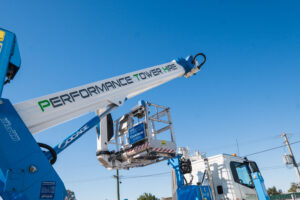
It’s beneficial for short-term projects or teams that don’t regularly operate elevated work platforms. Rather than spend time organising training or risk falling short of compliance, you get a qualified expert who shows up, gets the job done, and keeps your team safe.
Performance Tower Hire’s wet hire services are also handy if you’re working at height over 11 m and can’t spare someone with a WP class licence. We tick the compliance box for you.
Looking to keep your crew focused on the actual work, not bogged down by red tape? Wet hire delivers peace of mind, speed, and safety without the licensing headache.
Contact Performance Tower Hire
Performance Tower Hire is a Brisbane local, looking after working-at-height jobs all across South East Queensland. Our gear is reliable and impeccably maintained, and our team are friendly, professional and easy to deal with.
Whether you need a 16m cherry picker for tight access work, or a 54 m truck-mounted EWP for serious height, our fleet covers the lot. Our gear is fully insured, safety-checked and ready for action 24/7.
Check out our cherry picker hire options here.
Conclusion
So, do you need a licence to operate a cherry picker? If it’s over 11 m, yes. Under 11 m? Maybe not legally, but you still need to know what you’re doing.
What do you need? The team at Performance Tower Hire is always ready to talk through your options and help you get set up, licence or a licence.
Need help right now? Get in touch. You’ll speak to someone who knows their stuff and gets straight to the point.
FAQs – Do You Need a Licence to Operate a Cherry Picker?
Why is a licence needed to operate a cherry picker?
It demonstrates your competence, training, and compliance, essential on regulated job sites.
Why is maintaining competency part of licence renewal?
Licences are only valuable if you stay up to date. Refresher training keeps your knowledge sharp.
Why is proof of licence or a Yellow Card necessary on-site?
It’s how employers and inspectors know you’re approved to operate the equipment safely.
Why does Yellow Card training suffice under 11 m?
Because it’s nationally recognised and matches the risk level of shorter lifts.
Why does SafeWork demand licensed operators for HRW?
To reduce risks and ensure operators understand their responsibilities in high-risk environments.
If you’ve ever looked up at a sign install or a roof repair and wondered what cherry pickers are and why tradies rely on them, this guide is for you. A cherry picker is a mobile elevating work platform (MEWP/EWP) with a hydraulic boom and a platform or bucket that safely lifts workers and tools to height. Once used in orchards, today they’re essential in construction, maintenance, utilities, arboriculture, signage, and events because they combine reach, safety, and efficiency.
Performance Tower Hire provides wet and dry hire across Brisbane and South East Queensland with a fleet ranging from 16 m to 54 m. If you need advice or pricing, get in touch with our expert team!
How a Cherry Picker Works
They use hydraulics to lift a platform or bucket, handy for spots you couldn’t get to safely otherwise. The layout might vary, but the basics don’t change much.
- Base/Chassis: Some can drive themselves around the site. Others sit on a truck so you can roll straight to the next job.
- Turntable/Turret: They spin a full 360 on most models, handy when you don’t want to keep shifting position.
- Boom: You’ve got two main kinds, articulated booms, which bend to get over stuff, and straight booms that just reach right out.
- Controls: There are controls up top and on the ground, with extras like emergency controls and safety switches built in.
- Fall protection points: There are anchor points built in so operators can clip on their harnesses.
Power Options
- Electric cherry pickers: They’re compact and don’t make a racket or stink the place up, so they’re good for indoors, think warehouses, shops, or fit-outs. They are also good for night works where noise is a consideration.
- Diesel cherry pickers: More power, more runtime, and built for tough conditions, perfect for jobs out in the open.
Height and Outreach
They all top out at different heights and reach. Ours go from 16 to 54 metres, so whether it’s a small job or a big multi-storey setup, you’re covered.
Types of Cherry Pickers
Different jobs call for different machines. Here are the most common types you’ll run into:
Articulated (Knuckle) Boom
These ones bend in a few spots, so the platform can get up and over things, handy for tight spots like over roofs, past awnings, or through trees. You’ll usually see the electric ones used inside, while diesel’s better for outdoors.
Telescopic Boom Lifts
These extend straight out, making them solid for things like installing big signage, working on bridges, or setting steel, any job where you need to go long without stuff in the way.
Truck-Mounted EWPs
Truck-mounted models are easy to move from site to site. They’re a go-to for power, comms, and sign teams who need to knock out a bunch of jobs without wasting time.
Compact & Indoor Models
These little units are slim enough to get through regular doorways and tight aisles. Great for inside spots where there’s not much room, and you don’t want loud engines or exhaust in the air.
Scissor Lifts vs Cherry Pickers
Scissor lifts just go up and down and give you a bit more room to move, good for ceilings or grabbing stock off high racks. Cherry pickers can reach out and around, so they’re better when you’ve got to reach over stuff.
Want the full breakdown? Check out the piece on how boom lifts and cherry pickers stack up.
Common Uses of Cherry Pickers
Practical cherry pickers cover a wide range of industries and tasks:
Construction and Maintenance
If you need to get up high for things like cleaning windows, painting, sealing, or roof work, a cherry picker’s the way to go. On reno jobs, they’re quicker than setting up a full scaffold.
Electrical and Telecoms
Utility crews use cherry pickers for all sorts of stuff, fixing power lines, swapping out streetlights, or working on comms gear up poles or buildings. The truck-mounted ones are easy to shift so that crews can hit a bunch of sites in a day.
Signage and Events
Cherry pickers get used for all sorts of installs, billboards, shopfront signs, and even stadium lights. Event crews use them for hanging lights and sound gear, and sometimes for camera rigs at concerts or shoots.
Arboriculture
They’re common with arborists and council crews for trimming, storm jobs, or cutting out dangerous limbs. Safer than dragging a saw up a tree. They even get used for wildlife rescues when nests are out of reach.
Emergency Access
In a pinch, storms, fires, rescues, and cherry pickers get crews up high quickly. They’re steady too, which is why emergency teams keep them on hand.
Benefits of Using Cherry Pickers
Key benefits of cherry pickers on site include:
Safer access than scaffolding
Cherry pickers give you a steady platform with tie-off points, so there’s less chance of slipping. It’s a much safer and more seamless process than building scaffolding and clambering up it to work on a job.
Faster setup and repositioning
Setting up a cherry picker once it’s on site takes no time at all. When you’re done with one spot, transportation to the next site is easy and efficient.
Higher productivity
Because they reach up and out, you can also reach a bunch of spots without moving the machine. That means less mucking around and more work done in the same day.
Flexibility across environments
Whether it’s small electrics for inside work or big truck-mounted rigs for rough ground, there’s a cherry picker to match. That’s why you see them everywhere, from construction sites to sign jobs, tree work, and telecoms.
Cost efficiency
When you hire a cherry picker, you get exactly the machine you need for that job. There’s no wasted money on equipment sitting idle. Plus, you skip the upkeep, storage, and big purchase cost.
For details on what influences hiring rates, see How Much Does Cherry Picker Hire Cost?
Safety Requirements in Australia
Cherry pickers are considered high-risk gear, so site leads and operators have to follow the rules, planning, training, and safe use.
Key Safety Steps
- Pre-start checks: Test all controls, emergency-lowering, brakes, tyres, guardrails, and interlocks. Record findings in the logbook and tag out any faults.
- Ground assessment: Confirm surface strength, slope, and underground services. Throw pads under the outriggers if the ground calls for it, and keep away from sketchy spots, edges, pits, that sort of thing.
- Exclusion zones: Put up signs or barriers so cars and people don’t wander into the work zone. Use traffic control on public roads.
- Overhead hazards: Before you start, scan the area for hazards like wires, trees, or nearby edges. If it’s risky, stay back or call the utility to cut it.
- Weather limits: Keep within the machine’s wind rating. Watch for gusts, rain, and lightning. Measure wind where the platform is working, not just at ground level.
- Harness use: Clip to approved anchor points in the basket of the cherry picker. Adjust the lanyard length to prevent ejection. Follow site rules for scissor lifts.
- Load management: Stay within the platform’s rated capacity (people + tools)—secure materials; never climb guardrails or use ladders in the basket.
- Spotter and communication: Use a trained spotter in public or congested areas. Agree on hand signals or radio calls before starting.
Licences and Training
- A High Risk Work (WP) licence is required for boom-type EWPs with a boom length of 11 m or more.
- For smaller machines, operators still need proof of competency. The EWPA Yellow Card is a widely accepted training for common EWP categories.
- Keep copies of licences and competency records on site.
Check out our comprehensive article on whether a license is required for cherry picker use.
Planning and Documentation
- Sort out a SWMS/JSEA that spells out the risks, how you’re managing them, what to do in a rescue, and who’s on each job.
- Make sure the operator’s manual stays in the machine. Make sure emergency numbers and the site address are easy to find.
- Confirm permits where needed (after-hours works, road occupancy, power isolation).
Emergency Readiness
- Have a rescue plan before elevating. At least one person on the ground must be able to operate the ground controls.
- Check that emergency-lowering devices are working and reachable.
- Keep first aid gear close to the work area.
Inspection, Maintenance, and Records
- Complete daily pre-starts and keep a logbook in the machine.
- Schedule periodic inspections by a competent technician and retain service records.
- Remove from service immediately if defects are found, and label the machine “out of use” until repaired.
Avoiding Mistakes
A lot of mistakes come down to simple stuff, ordering the wrong size, forgetting to check the ground, or setting up under wires.
For practical tips, see Mistakes to Avoid When Hiring a Cherry Picker.
How to Choose the Right Machine?
Picking a cherry picker? Keep these points in mind so you don’t run into headaches on the job.
- Height and outreach: Think about how high the work is and whether obstacles will get in your way.
- Site conditions: Check the ground before you set up, for a solid footing, not much slope, and enough room to get through the gates or doors.
- Power source: Electric ones are better indoors or anywhere you need them to be quiet. Diesel’s the go for outside jobs and rough ground.
- Capacity: Don’t forget to count the weight of whoever’s in the bucket, plus their gear and materials.
- Hire type: Wet hire, where you get an operator, makes sense for tricky jobs. Dry hire’s fine if you’ve already got licensed people who know the gear.
Need help choosing? The Cherry Picker Hire Brisbane team can match the right machine to your site and task.
Wrap-Up
What Are Cherry Pickers and Which One Do You Need?
By now, you’ve got the gist, cherry pickers are a safer way to get work done at height. Whether it’s a small electric for warehouses, a straight boom for long reach, or a truck unit for moving site to site, picking the right one keeps the job running smoother.
If you’re in Brisbane or South East Queensland, contact Performance Tower Hire for expert guidance and dependable equipment.
FAQs
Why are cherry pickers used in construction and maintenance?
They get you up high quicker and safer than messing around with ladders or scaffolding.
Why should businesses hire instead of buy?
Hiring avoids ownership costs and allows you to use the right machine for each job.
Why are electric cherry pickers popular indoors?
They are compact, quiet, and safe for enclosed environments.
- 1
- 2


